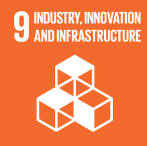SDG9 – Industry, Innovation and Infrastructure

New Vocabulary
- industry
- innovation
- infrastructure
- LDC
- manufacturing
- production
- recoup
- loss
- gain
Practice the new vocabulary
Industry, Innovation and Infrastructure Vocabulary (text version)
Match the words to their definitions:
Words:
- recoup
- industry
- innovation
- loss
- production
- manufacturing
- infrastructure
- gain
- LDC
Definitions:
- businesses that make and sell items
- a new or original idea
- the systems that a country has in place to run smoothly
- Least Developed Countries
- producing items in factories
- the act of making things
- to get back money you lost
- spending more than you earn
- an increase in value
Check your answer in footnote[1]
Activity source: Industry, Innovation and Infrastructure Vocabulary by Virginia McHardy, CC BY-NC 4.0
Industry, Innovation and Infrastructure
According to the United Nations Department of Economic and Social Affairs (n.d.) Goal 9 Infographic:
Goal 9 is about building strong infrastructure, supporting sustainable industries, and encouraging new ideas and technology. These things are important for growing the economy, helping people, and protecting the environment.
Before COVID-19, global manufacturing (which is important for economic growth) was already slowing down because of trade problems. The pandemic made this worse, causing big problems for the economy. High prices, expensive energy, and trouble getting materials have all added to the challenges.Some poorer countries in Asia are making good progress, but African countries need to work much harder to reach the 2030 goals. On the bright side, industries that use advanced technology are growing well.
Canadian Perspective
Goal 9, Industry, Innovation and Infrastructure (text version)
Build resilient infrastructure, promote inclusive and sustainable industrialization and foster innovation
Manufacturing jobs in Canada
Manufacturing jobs accounted for 9% of all jobs in 2021. A 3% decrease since 2015. The highest percentage of manufacturing jobs was in Quebec at 12% while the lowest proportion was in Newfoundland and Labrador at 5%.
Greenhouse Gas Emissions and Infrastructure Assets
In 2021, 0.33 tonnes of greenhouse gas emissions was emitted per $1,000 of infrastructure assets production. This is a 10% decrease since 2015. Transportation machinery and equipment production emitted the most greenhouse gas emissions with 0.51 tonnes per $1,000.
Gross Domestic Product and Research and Development
Gross domestic expenditures on research and development in 2021[2] represented 1.6% of total gross domestic product, down from 1.7% in 2015. The top funding sectors were the business enterprise (44%), higher education (20%), and the federal government (18%).
Community Spotlight: Actua
Actua delivers inclusive and accessible STEM learning experiences and professional development opportunities to prepare youths for careers in the most promising industries. The annual impact of Actua includes 350,000 youths engaged, 500 communities reached across Canada and 1,000 post-secondary students employed.
Source(s): Statistics Canada, Survey of Employment, Payrolls and Hours, 2021. Statistics Canada, Stock and Consumption of Fixed Non-residential Capital, 2021. Statistics Canada, Gross Domestic Expenditures on Research and Development (GERD), 2022. Actua, 2022.
Source: Goal 9, Industry, Innovation and Infrastructure In Agenda 2030 Sustainable Development Goals Report, 2022 by Statistics Canada, used under Open License
Discussion Questions
Use the new vocabulary words in these discussion questions. Ask and answer in partners or small groups:
- What industries are most important in your country’s economy? Why?
- How does innovation help industries become more competitive?
- How can international organizations help LDCs improve their infrastructure and innovation?
- How has manufacturing changed over the past 20 years due to technology?
- How can industries balance high production levels with sustainability?
- What strategies can governments use to help industries recoup losses after natural disasters?
- What are some common reasons for financial losses in industries?
- Can you give an example of a company or country that gained success through innovation?
- What are some emerging industries that you think will be important in the future?
Watch the video
Watch Goal 9 – Industry, innovation and infrastructure (2 mins) on YouTube
Video source: UNStats. (2022, July 7). Goal 9 – Industry, innovation and infrastructure [Video]. YouTube. https://www.youtube.com/watch?v=Xx1KgyJUxj4
Industry, Innovation and Infrastructure Video Questions (text version)
- True or false? Most factories worldwide have come back successfully after the pandemic.
- Fill in the missing words: LDCs, which means [Blank A] have not caught up to the rest of the world in terms of manufacturing.
- What companies are more likely to survive in times of trouble?
- Traditional companies
- Family-run businesses
- Companies that use automation
- Use the numbers to fill in the blanks and complete this sentence:
Numbers: 4.5 billion, 2.2 billion, 2021, , 2.3, 4, 2019
Sentence: Airline companies have lost [Blank A] passengers from [Blank B] to [Blank C]. There were approximately [Blank D]flyers to start as opposed to [Blank E] billion customers [Blank F] years later. - Fill in the blank to complete this sentence:
Unfortunately, one out of [Blank A] careers in industry were adversely affected by the pandemic.
Check your answer in footnote[3]
Activity source: Industry, Innovation and Infrastructure Video quiz by Virginia McHardy, CC BY-NC 4.0
You can read more about Goal #9 in The Sustainable Development Goals Report 2022 from the UN.
Key Targets for SDG 9
- 9.1 Develop quality, reliable, sustainable and resilient infrastructure, including regional and transborder infrastructure, to support economic development and human well-being, with a focus on affordable and equitable access for all.
- 9.2 Promote inclusive and sustainable industrialization and, by 2030, significantly raise industry’s share of employment and gross domestic product, in line with national circumstances, and double its share in least developed countries.
- 9.3 Increase the access of small-scale industrial and other enterprises, in particular in developing countries, to financial services, including affordable credit, and their integration into value chains and markets.
- 9.4 By 2030, upgrade infrastructure and retrofit industries to make them sustainable, with increased resource-use efficiency and greater adoption of clean and environmentally sound technologies and industrial processes, with all countries taking action in accordance with their respective capabilities.
- 9.5 Enhance scientific research, upgrade the technological capabilities of industrial sectors in all countries, in particular developing countries, including, by 2030, encouraging innovation and substantially increasing the number of research and development workers per 1 million people and public and private research and development spending.
- 9.a Facilitate sustainable and resilient infrastructure development in developing countries through enhanced financial, technological and technical support to African countries, least developed countries, landlocked developing countries and small island developing States.
- 9.b Support domestic technology development, research and innovation in developing countries, including by ensuring a conducive policy environment for, inter alia, industrial diversification and value addition to commodities.
- 9.c Significantly increase access to information and communications technology and strive to provide universal and affordable access to the Internet in least developed countries by 2020.
Source: United Nations Department of Economic and Social Affairs. (n.d.). Goal 9 [Infographic]. Sustainable Development Goals. https://sdgs.un.org/goals/goal9

Homework/Assignment:
Write a letter to a city official proposing an idea for improving local infrastructure.
- Identify a problem (e.g., traffic, unreliable internet, lack of public transport).
- Propose a solution.
- Explain how the solution aligns with SDG 9 goals.
You can read more about Goal #9 in The Sustainable Development Goals Report 2022 from the UN.:
For instructors, please visit York University’s The SDGs-in-the-Classroom Toolkit for lesson ideas
Attribution & References
Except where otherwise noted, this page is created by Virginia McHardy, CC BY-NC 4.0
References
United Nations Department of Economic and Social Affairs. (n.d.). Goal 9 [Infographic]. Sustainable Development Goals. https://sdgs.un.org/goals/goal9
- 1. industry, 2. innovation, 3. infrastructure, 4. LDC, 5. manufacturing, 6. production, 7. recoup, 8. loss, 9. gain ↵
- The gross domestic expenditures on research and development figures include preliminary data and intentions data. ↵
- 1. True, 2. Lowest Developed Countries, 3. c., 4. a) 2.2 billion, b) 2019, c) 2021, d) 4.5 billion, e) 2.3, f) 4. 5. three or 3 ↵
the systems that a country has in place to run smoothly
producing items in factories
businesses that make and sell items

